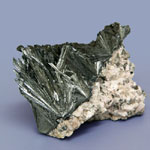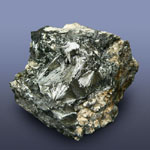Oxides and hydroxides: Pyrolusite
 Diagnostic card.
Diagnostic card.
MnO 2 (manganese oxide)
Tsingonia tetragonal
Hardness 6-6,5
Specific weight 4.7-5.1
Cleavage is absent
Cracked shell
Color: dark gray, black
Color in powder black
Glitter semimetallic

It is a black powdery mineral. It is most often associated with other minerals of manganese, mostly non-crystalline. Such an association was called Vad. You can find pyrolusite in the form of earthy masses, fibrous aggregates, concretion bonds. Very rarely it is a prismatic black crystal; In this case it is called polyanite.
Name from the Greek, pyre - fire and ioysis - washing. Together with psilomelanom pyrolusite - the main manganese ore. Used for the production of chlorine, in the glass business (for discoloration) and smelting of special grades of steels.
Rarely found in the form of idiomorphic crystals - a variety of polyanite (hardness 6.5, metallic shine), pseudomorphic manganite. Pyrolusite forms radiant-crystalline masses, solid or earthy-friable; Marked as graphite. Cleavage in two directions; Density about 5; Hardness is difficult to determine, crumbles easily; Color is gray to black.
Chemical composition. Manganese (Mn) 63.2%, oxygen (O) 36.8%. Form of crystalline precipitates. Crystals are rare, only in voids can be found needle or columnar forms; For the most part, the mineral forms dense, thin (crypto) crystalline, earthy (loose) masses. Crystal structure. Lattice lattice type rutile. Class of symmetry. Ditetragonal-bipyramidal - 4 / mmm. Aggregates. Dense, reniform and stalactite-like formations, nodules, radiant and fibrous intergrowths.



Diagnostic signs.
The earthy variety gives a very characteristic feature of black color. When heated, the mineral becomes solid.
Origin.
Has a sedimentary genesis. Formed as a chemical sediment in ancient lakes, marshes, lagoons under conditions of weak water circulation, but with a high oxygen content. It can also exist as a secondary mineral formed during the oxidation of manganese minerals.
Deposits and applications.
Large deposits of dense vada and pyrolusite were found in Georgia, the Dekan (India), the state of Minas Gerais (Brazil) and South Africa. Pyrolusite is an important ore for manganese.
Pyrolusite and its varieties (psilomelan, vad, etc.) are very similar in composition, but have different appearance and properties. They were formed in the weathering zone ("iron hat") from manganese-bearing vein minerals - rhodonite, rhodochrosite, siderite, dolomite and others, (Westphalia, Thuringia in Germany). Typically, the sedimentary origin of the most known deposits of manganese ore: Nikopol (Ukraine) and Chiatura (Georgia). Sometimes the mineral was formed as a result of leaching and oxidation.
ADR 5.1

Substances that are oxidized
Risk of violent reaction, ignition or explosion if exposed to flammable or flammable substances
Do not allow the formation of a mixture of cargo with flammable or combustible substances (eg sawdust)
Yellow diamond, ADR number, black flame above the circle
ADR 4.2

Substances that are capable of self-ignition
Risk of fire due to autoignition in the event that the packaging is damaged or the source of the contents has occurred.
Can react violently with water
White upper half of diamond, red - lower, equal, ADR number, black flame
ADR 4.1

Highly flammable solids , self-reactive substances and solid desensitized explosives
Risk of fire. Flammable or combustible substances can ignite from sparks or flames. May contain self-reactive substances capable of exothermic decomposition in the case of heating, contact with other substances (such as: acids, heavy metal compounds or amines), friction or impact.
This can lead to the emission of harmful or flammable gases or vapor or spontaneous combustion. Containers can explode when heated (over-dangerous - practically do not burn).
Risk of explosion of desensitized explosives after loss of desensitizer
Seven vertical red stripes on a white background, equal in number, ADR number, black flame
ADR 8

Corrosive (corrosive) substances
Risk of burns from skin corrosion. They can react violently with each other (components), with water and other substances. The substance that spilled / crumbled can emit a corrosive vapor.
Dangerous to aquatic environment or sewer system
White upper half of diamond, black - lower, equal, ADR number, test tubes, hands
ADR 9

Other dangerous substances and articles
Risk of burns. Risk of fire. Risk of explosion.
Dangerous to aquatic environment or sewer system
Seven vertical black stripes on white background - top, white - lower half of diamond, ADR number
ADR 4.3


Substances that emit flammable gases in contact with water
Risk of fire and explosion if exposed to water.
The cargo, which crumbled, must be covered and kept dry
Blue and blue diamond, ADR number, black or white flame
| The name of a cargo that is particularly dangerous for transportation | room
UN |
Class
ADR |
| MARGANZA (II) NITRATE | 2724 | 5.1. |
| Manganese (IV) oxide | 1479 | 5.1. |
| Manganese ethylene-1,2-bisdithiocarbamate MANEB or MANEBA PREPARATION, which contains not less than 60% maneb | 2210 | 4.2 |
| MARGANZA RUBBER | 1330 | 4.1 |
| Manganese sulfate, solution | 3082 | 9 |
| Manganese phosphate | 3260 | 8 |
| Manganese ethylene-1,2-bisdithiocarbamate, stabilized against self-heating MANEB STABILIZED or MANEBA | 2968 | 4.3 |
| STABILIZED AGENT against self-heating | 2968 | 4.3 |
| MANEB or MANEBA PREPARATION, which contains at least 60% maneb | 2210 | 4.2 |
| MANEB STABILIZED OR MANEBA STABILIZED STABILIZED AGAINST HEAT REFRIGERATION | 2968 | 4.3 |
| MANITGEXINATRATE (NITROMANITE) HYDROGEN with a mass fraction of water or a mixture of alcohol and water of at least 40% | - | - |
- Ghetchellit - "New Almaden blend" - arsenide and antimony sulfide (modern sulfosol)
- Antimony is a toxic metal (semimetal) , widely used in metallurgy, medicine and engineering
- Zirconium - a rare and undiscovered metal and the most dangerous precious stone in oxide and salt
- Gold - yellow dangerous and poisonous metal of modern accurate digital and cable technologies
- Sulfur is a golden-yellow toxic substance and a sign of active volcanic activity
- Cadmium is an undisputed toxic silvery metal unknown to a wide range of people
- Lead - a toxic gray imitator of metallic silver and toxic metal blende
- Arsenic is a classic poison of medieval and modern poisoners and medicine in medicine
Poisonous and radioactive dangerous stones and minerals
** - poisonous stones and minerals (mandatory check in the chemical laboratory + explicit indication of toxicity)
** - radioactive stones and minerals (mandatory check on the standard dosimeter + ban on open sales in case of radioactivity exceeding 24 milli / g / h + additional measures of population protection)
Catalog of minerals and semi-precious stones of the world by groups
** - poisonous stones and minerals
** - radioactive stones and minerals


Comments
When commenting on, remember that the content and tone of your message can hurt the feelings of real people, show respect and tolerance to your interlocutors even if you do not share their opinion, your behavior in the conditions of freedom of expression and anonymity provided by the Internet, changes Not only virtual, but also the real world. All comments are hidden from the index, spam is controlled.